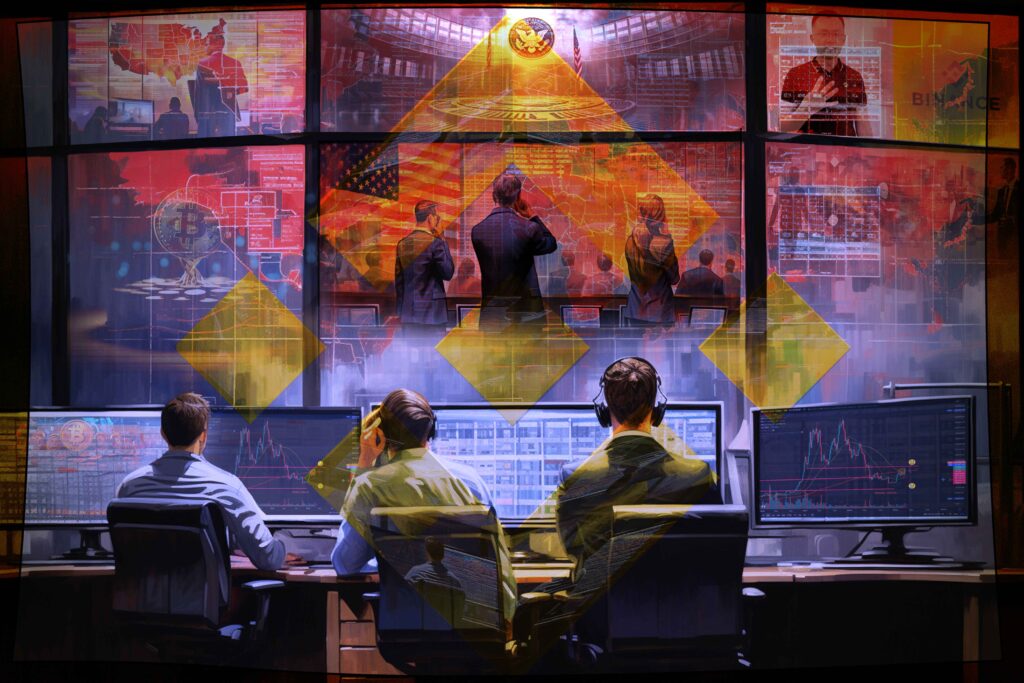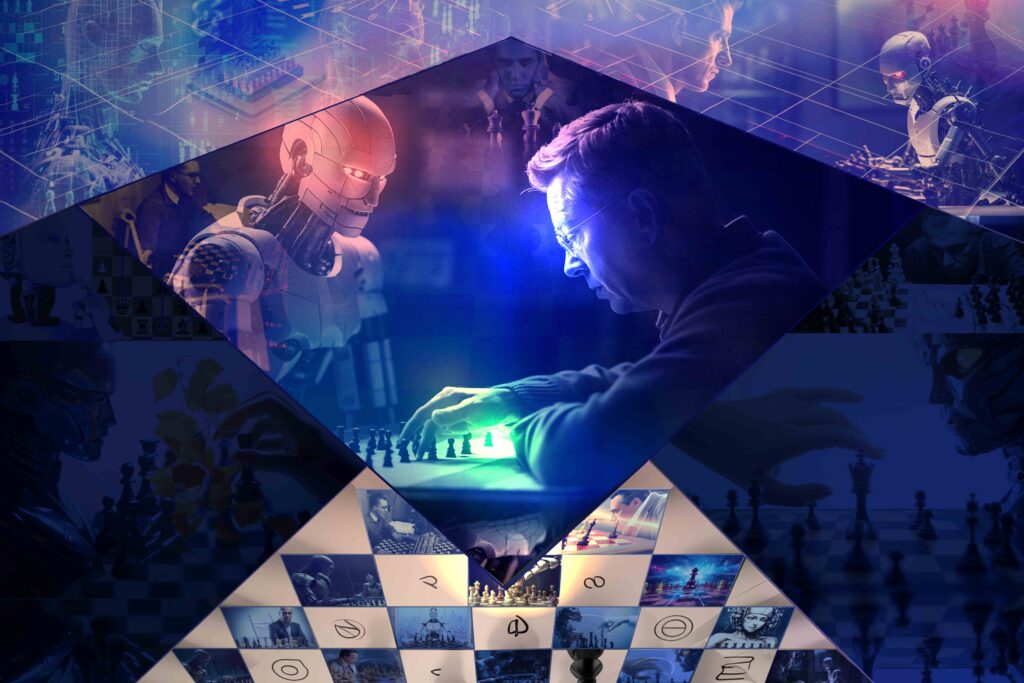Let us know your thoughts! Sign up for a Mindplex account now, join our Telegram, or follow us on Twitter.
BitVM: Revolutionizing Bitcoin Contracts
Introduction
BitVM is a groundbreaking computing paradigm that enables Turing-complete Bitcoin contracts without altering the network’s consensus rules. It operates on a verification principle similar to optimistic rollups, where computations are verified rather than executed on Bitcoin. The system requires minimal on-chain footprint, allowing complex computations without leaving traces in the chain. On-chain execution is only needed in disputes. This article explores the capabilities of BitVM and its architecture.
Expanding Bitcoin’s Capabilities
BitVM expands Bitcoin’s smart contract capabilities beyond basic operations like signatures, timelocks, and hashlocks. This opens up a whole new design space for more expressive Bitcoin contracts and off-chain computation. Imagine being able to play games like Chess or Poker directly on the Bitcoin network or verifying validity proofs in Bitcoin contracts. These are just some of the potential applications of BitVM.
The Architecture of BitVM
The architecture of BitVM is a fascinating blend of existing technologies and novel approaches. It bears similarities to Optimistic Rollups and the MATT proposal, both of which are well-known concepts in the blockchain space. However, what sets BitVM apart from these systems is its compatibility with the existing Bitcoin network. BitVM requires no changes to Bitcoin’s consensus rules, which means it can operate within the existing infrastructure of Bitcoin. This is a significant advantage as it allows for the implementation of BitVM without disrupting or dividing the Bitcoin network. In essence, BitVM’s architecture can be seen as a bridge between the robustness and security of Bitcoin’s existing infrastructure and the need for more complex and expressive contracts. It leverages the strengths of existing technologies while introducing new capabilities, creating a balance between innovation and compatibility.
Committing to Circuits
In computer science, any computable function can be represented as a Boolean circuit. BitVM applies this principle by expressing any circuit by composing gate commitments. It’s like creating an intricate blueprint for a machine where every step of execution is committed to in a Tapleaf. All these Tapleaves are combined into the same Taproot address, allowing the prover to execute any gate in the circuit.

Ensuring Fair Play
Of course, there need to be rules to ensure fair play. In case of fraud, the verifier can challenge the prover’s statement using a sequence of pre-signed transactions. If one party stops engaging, after some timeout, the other party wins the challenge and can take both deposits. This mechanism ensures that both parties have skin in the game and are incentivized to play fair.
Inputs and Outputs
In the BitVM system, the prover can set inputs by revealing corresponding bit commitments. A bit commitment is a cryptographic protocol that allows the prover to commit to a chosen value while keeping it hidden from others. In an ideal scenario, these commitments are revealed off-chain. This is done to minimize the on-chain footprint, which is the record of transactions on the blockchain. Minimizing the on-chain footprint is beneficial as it reduces the load on the blockchain network and enhances its scalability. However, in non-cooperative cases, the verifier can force the prover to reveal their inputs on-chain. This ensures transparency and allows for verification of transactions.
Limitations
While BitVM is efficient for expressing functions in simple NAND circuits, it is currently limited to two parties. However, it might be possible to have two-way channels and form a network similar to Lightning Network. Future research could explore combining BitVM with different off-chain protocols like Lightning Network or rollups.
Conclusion
BitVM has the potential to revolutionize Bitcoin contracts by enabling Turing-complete capabilities without altering the network’s consensus rules. By allowing verification of program execution through fraud proofs in large Taptrees, It expands Bitcoin’s smart contract capabilities and operates within the existing infrastructure of Bitcoin. With its unique architecture and commitment to fair play, BitVM opens up new possibilities for expressive contracts while maintaining compatibility with the robustness and security of Bitcoin. As the technology evolves, it will be exciting to see how BitVM integrates with other off-chain protocols and further enhances the Bitcoin ecosystem.
Let us know your thoughts! Sign up for a Mindplex account now, join our Telegram, or follow us on Twitter.
Why Did Binance and CZ Settle With US Authorities for $4.3 Billion?
Introduction
A feared potential black swan event has come and gone in crypto with little fanfare. Binance, the world’s largest cryptocurrency exchange, and its popular founder/CEO Changpeng Zhao, better known as CZ, have reached a massive settlement with U.S. authorities, marking a significant turning point in the crypto industry’s relationship with regulators as the next bull run looms large thanks to incoming catalysts like the BlackRock Bitcoin spot ETF and Bitcoin Halving. This comes on the back of the SEC also again going “back for seconds” against Kraken and publishing a list of what it considers crypto securities.
The U.S. Securities and Exchange Commission (SEC) had previously filed 13 charges against Binance and its CEO for: operating unregistered exchanges, broker-dealers, and clearing agencies, and misrepresenting trading controls and oversight. The CFTC, on the other hand, charged Binance and CZ with willful evasion of federal law and operating an illegal digital asset derivatives exchange.
The settlement, announced on Nov 21 and 22, 2023, sees Binance paying a whopping $4.3 billion. This settlement is the largest in Treasury history according to Janet Yellen, with CZ personally paying $50 million to the CFTC and posting bail for $175 million in order to return to his home in the UAE on bail.
The charges against CZ are very serious and included failure to maintain an effective anti-money laundering program at the crypto exchange in violation of the Bank Secrecy Act which birthed regulations such as the so-called Travel Rule requirement.
As part of the settlement, CZ pleaded guilty to breaking U.S. anti-money laundering laws and agreed to step down from his role as CEO of Binance. It was announced on Nov 22 2022 that he has been replaced by the experienced ex-Abu Dhabi regulator Richard Teng in order to provide some much-needed stability at the world’s biggest crypto exchange. Zhao could see jail time if convicted.
What’s next for Binance?
CZ will retain his stake in Binance, which could allow him to continue exerting some influence on the company. This is highly unlikely in the short term, as the criminal cases against him are ongoing and his behavior will be heavily scrutinized. Zhao’s demise at Binance draws comparisons with other axed exchange heads like FTX founder Sam Bankman-Fried (due for sentencing in 2024) and Arthur Hayes, previously the head of controversial exchange BitMEX, who faced similar charges in 2020.
Both FTX and BitMEX embraced full compliance with anti-money laundering legislation after the departure of their founders; and the same is likely in store for Binance under the guidance of Teng. He stated that his focus would be on “reassuring users that they can remain confident in the financial strength, security, and safety of the company” and is a strong advocate for regulatory compliance.
The settlement also includes the appointment of independent compliance monitors for three- and five-year terms. These monitors will have sweeping powers to oversee Binance’s business practices, including how it adds new customers and how it interacts with jurisdictions subject to U.S. sanctions or surveillance.
The Binance result is a highly significant development in the ongoing scrutiny of cryptocurrency exchanges by U.S. authorities. It sends a clear message to the industry about the importance of compliance with U.S. laws and regulations. Despite the hefty penalties, the settlement allows Binance to continue operating and potentially marks the start of a new chapter for the world’s largest exchange as well as the crypto industry.

Why did the SEC charge Binance and CZ?
The SEC previously filed 13 charges against Binance entities and CZ, alleging that since at least July 2017, Binance.com and Binance.US, while controlled by Zhao, operated as exchanges, brokers, dealers, and clearing agencies, earning at least $11.6 billion in revenue from transaction fees from U.S. customers.
The SEC charged Binance for the unregistered offers and sales of BNB, BUSD, and crypto-lending products known as ‘Simple Earn’ and ‘BNB Vault’.
In addition to the SEC’s charges, Binance and CZ faced accusations from the U.S. Department of Justice and the U.S. Commodity Futures Trading Commission (CFTC). The CFTC sued Binance for offering unregistered crypto derivatives in the U.S., alleging that Binance had a “maze of corporate entities” demonstrating the exchange’s “willful evasion of U.S. law”.
Binance settles, CZ pleads guilty to AML violations
In response to these charges, Binance and CZ have agreed to a series of settlements. CZ pleaded guilty to failing to maintain an effective anti-money laundering (AML) program, in violation of the Bank Secrecy Act (BSA), and has resigned as CEO of Binance.
As part of the plea agreement, Binance has agreed to forfeit over $2.5 billion and to pay a criminal fine of over $1.8 billion, for a total financial penalty of over $4.3 billion. CZ will also pay a $50 million fine to the CFTC and may face potential prison time when he gets sentenced in 2024, ironically before Sam Bankman-Fried.
In addition, Binance will make a “complete exit” from the U.S. (Binance.US, a different entity, will remain) and agree to strict oversight from monitors over the next several years.
These legal actions and settlements mark a significant moment in the regulation of the cryptocurrency industry. The SEC and other federal agencies have been increasing their scrutiny of cryptocurrency exchanges and other entities in what is known as Operation Chokepoint 2.0, seeking to enforce compliance with securities laws and other regulations.
The actions against Binance and CZ are part of this broader trend, and the dominant exchange’s meek surrender could have significant implications for the future of the cryptocurrency industry which is gradually being reined in by regulators around the world.
The settlements and CZ’s resignation may serve as a fresh start for Binance, which had been hamstrung by widespread market fears that U.S. authorities will shut it down globally. The settlement was seen as the only way for Binance to continue its business, giving them a fresh start in 2024 if all goes to plan.
With powerful new TradFi entrants like BlackRock and Fidelity knocking on its door, Binance’s actions are also bullish for the entire crypto industry, helping it to clear its collective closet of skeletons that regulators like Gary Gensler can point to when they argue that the whole market is manipulated.
Let us know your thoughts! Sign up for a Mindplex account now, join our Telegram, or follow us on Twitter.
WTF is Retro-causality?
How to Teach Proto-AGIs Unconditional Love
Checkmate Continuum: The Evolution of AI Chess Engines
Chess, with its blend of strategy, foresight, and intellect, has captivated the human competitive spirit for centuries. Its origins trace back to ancient India, meandering through Persia, where it picked up the name ‘Shah Mat’ (‘the King is helpless’). In time, chess won global appeal – with millions worldwide hooked on this mental battleground, kings and pawns dance a strategic pattern towards victory or defeat.
Computation and automated logic machines found a fast companion in chess. The structured, rule-bound universe of chess clicked with the wheels of early computers, and the journey of chess and early AI began, giving birth to what we now know as AI chess engines.
Let’s dive deeper into the intersection between chess and machine, exploring the birth, present, and future of AI chess engines.
The Chessboard Meets the Circuit Board: A Historical Intersection
The tale of chess and computation began before the electronic age. The earliest hint of a chess engine traces back to Alan Turing, the father of modern computer science. Turing conceptualized a theoretical machine that could mimic the cognitive processes of a chess player. Though his ideas remained on paper, they sowed the seeds for a future where chess would become a research area for computational logicians.
Turing’s theoretical musings soon turned into practical applications. In 1951, Ferranti Mark I, the world’s first commercially available general-purpose computer, played a game of chess. Though rudimentary by today’s standards, it birthed computational chess. Chess has always been a vanguard problem for AI. Solving chess was the first step towards AGI, an appealing problem on which to test the foundation circuits of the new neural machines.
In 1997, Garry Kasparov, the reigning world chess champion, found himself battling IBM’s Deep Blue. The encounter was more than a game – it was a showdown between human intellect and machine logic. The world watched as IBM’s Deep Blue triumphed, marking the first time a world champion was defeated by a machine under tournament conditions. Since that defeat, AI dominance in chess was assured. Engines like Stockfish and AlphaZero have ELO that far outstrips even Magnus Carlsen. It’s over – in chess, the machines have won.

Titans of the Chessboard: AI Engines vs Human Grandmasters
Stockfish, an open-source engine, is the zenith of directed evaluation, harnessing the power of extensive opening libraries and endgame tablebases. Its meticulous evaluation of millions of potential future positions brings brute force to back up this cleverness, combining into formidable tactical acumen.
AlphaZero, developed by DeepMind, took a new approach. It learned chess from scratch, with no pre-programmed knowledge apart from the basic rules. By playing astronomical numbers of games against itself, it achieved superhuman performance in a matter of hours, displaying a brand of chess that not only dominated human opponents, but was imbued with creativity once thought to be achievable only by organic neurons.
In a 100-game match, AlphaZero triumphed over Stockfish. This was a significant milestone. The robot-battle was a spectacle, with AlphaZero often choosing less-trodden paths and displaying a proclivity for dynamic, unconventional play.
This is key; AlphaZero’s chess looks nothing like human chess. The neural engine was displaying levels of insight that watching grandmasters have to back-engineer to figure out the logic. The calculation potential of modern machines might mean playing an entirely different game. AlphaZero’s intuitive pattern recognition make it feel ‘smart’. It isn’t some beefy Turing calculator plodding through billions of steps, but a truly ‘thinking’ machine, with insights akin to human eureka.
It hadn’t just ‘solved’ chess with raw processing power. That’s (probably) impossible. In sum, there are more possible moves in chess than atoms in the universe. And that’s if you only account for restricted sets of ‘sensible moves’. By turn one, Black has 900 moves. By turn twenty, it’s for all reasonable purposes already infinite. So far, we, even with immense processing power ‘dumb’ AI like Stockfish, can only calculate so far. That’s why AlphaZero’s pattern recognition is so enthralling, because it feels like our own – just aided and abetted by Stockfish-esque horsepower on top.
So the march of AI in chess doesn’t have to mean obsolescence for human players. Chess has been a standard bearer for AI for decades. Even though we admit our AI agents are better, perhaps there are things we can still learn from each other. Centaur chess is one such exploration, where human players use AI to play tournaments.
Checkmate Future: The Broader Implications of AI in Chess
In the training halls, AI chess engines are transforming the way players prepare and strategize. The ability of machines to simulate scenarios and dissect the implications of positions has become an invaluable tool for players aiming to hone their skills.
The evolution of AI in chess even has ripple effects beyond the game. The principles underlying the success of chess engines find resonance in other domains demanding strategic decision-making and problem-solving. Whether it’s optimizing complex logistics, navigating financial markets, or unraveling the mysteries of molecular structures, the essence of computational logic honed on the chessboard finds applications in many fields. Chess still holds a central place in AI research. Maia is one such example, a chess engine who makes human-like mistakes, and acts as a research platform for human AI interactions and naturalistic engagement in closed systems.
The saga of AI in chess is a microcosm of the larger narrative of AI in human society. It’s a narrative of augmentation, collaboration, and the ceaseless quest for knowledge. The chessboard, once a battleground of kings and queens, now stands as a battleground of men and machines, a symbol of a future where together, they venture into the realms of the unknown, chasing the shadow of perfection.
Let us know your thoughts! Sign up for a Mindplex account now, join our Telegram, or follow us on Twitter.
A Global Ensemble of Organoids | Highlights from Season 2
How To Benchmark Brain Uploads | Highlights from Season 2
How Are UFO Sightings, Time Travel and Unconditional Love Connected? | Highlights from Season 2
SocialFi: Trade Friends and Influence People With These Five Projects
In a recent article we discussed the rising popularity of social finance, also known as SocialFi or SoFi) in 2023. This fun and experimental new way of monetizing social networking has helped crypto degens entertain themselves during a bearish last 12 months, while providing a compelling new use case for Web3.
Much of this year’s hype has circled around Friend.tech, which tokenizes social media accounts kind of like a stock (don’t tell the SEC) and allows account holders to create monetized membership groups in the process. There has been a bit of controversy around its founders’ background and their role in a failed previous project named Kosetto (giving off some Do Kwon and Basis Cash vibes), however, it has certainly picked up organic traction despite this.
Project 1: Friend.tech (Base)
What is it?
Friend.tech is a decentralized platform for monetizing your social influence through tokenization. Built on the Base Network (a layer 2 network developed by Coinbase), Friend.tech allows users to own, tokenize, and trade Twitter profiles.
How it works
Friend.tech allows users to tokenize their online influence and attention and trade it as a token. The token was renamed from ‘Shares’ to ‘Keys’ in August. These Keys grant holders exclusive access to the app’s built-in chat rooms and content from creators. Fans can support content creators by buying shares in their profiles in the form of ‘Keys’.
Friend.tech users have chat groups that are similar to other apps such as Telegram. However, the difference is that group members must purchase Keys in order to access the group. A holder can sell the Keys if they want to leave the group, or earn a profit by trading the ‘Keys’.
Team
Friend.tech was created by pseudonymous founder 0xRacer and his anon team.
They’d pulled in over $40 million in revenue by October 2023 and the app was at the time considered the biggest revenue-generating dApp on the Base network, and astonishingly, the 2nd biggest in all of crypto. It’s no surprise then that a plethora of copycat projects soon tried to emulate their success.
Project 2: Stars Arena (Avalanche)
Stars Arena is a fork of Friend.tech, built on the Avalanche network instead of Base. It is a decentralized social finance platform that allows creators to monetize their work and enables followers to connect with their creators.
Main Purpose
The purpose of Stars Arena is to give creators a platform where they can monetize their content. Creators sell Tickets (similar to Friend.tech’s Keys), which equate to shares of their platform, to their followers. Followers can buy and sell the creators’ tickets using the AVAX cryptocurrency.
How Stars Arena Works
Stars Arena allows users to have fractional ownership of Twitter profiles of content creators, influencers, or celebrities. By purchasing Tickets, users have the right to engage with content creators in a more personalized way.
Ticket holders can communicate with content creators via direct messages. Content creators can upsell the price of their Tickets by using various methods such as offering valuable info with restricted access. The platform has a tipping feature that enables users to reward creators.
Stars Arena has a referral program where users can refer their peers to the platform and earn a 1% commission on every trade made by their referrals.
Stars Arena Team
Stars Arena was launched by an anonymous developer with the Twitter handle @hannesxda.
Project 3: Open Campus (BNB Chain)
Open Campus is a decentralized education-focused social platform that brings educators, content creators, parents, and students under one roof. The Open Campus protocol is powered by the $EDU token. Built on the BNB network, the EDU token can be used for:
- Paying content creators for their revenue share
- Minting NFTs from educational content
- Voting rights within the Open Campus ecosystem
Main Purpose
Open Campus is a platform that uses blockchain technology to build an education ecosystem. The platform decentralizes the creation of educational content so that students can access a wide range of learning material.
How Open Campus Works
Open Campus uses social incentives to promote the creation of valuable educational content. The platform works on the following premise:
- Digital rights – educational content is minted as non-fungible tokens (NFT) to enable the wider community to participate in alternative, decentralized learning.
- Decentralization – users can create and consume content whenever it suits them.
- Immutable records – the platform uses blockchain technology to ensure that certificates and qualifications are permanently recorded on the blockchain, and can be easily verified.
By launching educational content as NFTs, content creators and their partners can earn revenue based on their contributions.
Open Campus Team
TinyTap, an Israeli company founded in 2012 by Yogev Shelly and Oren Elbaz, acquired Open Campus. Open Campus counts Animoca Brands, Mocaverse, The Sandbox, Hooked Protocol, and GEMS Education as its partners.

Project 4: Hooked Protocol (BNB Chain)
Hooked Protocol is an edutainment network that utilizes gamified and immersive learning experiences to accelerate Web3 mass adoption.
How Hooked Protocol Works
Built on the BNB Chain, Hooked Protocol has bespoke Learn & Earn products that act as an on-ramp for attracting Web2 users to Web3.
The platform has built the following products to educate users about Web3:
- Quiz-to-Earn
- PoWT (Proof of Work and Time) Mining Game – a game that rewards users for contributing their effort and time to the Hooked Protocol ecosystem.
- Social referrals – users are incentivized to invite other users to the platform
- Stake and Swap – users can use the ecosystem’s wallets to stake and swap their crypto.
$HOOK, a BEP-20 token, is the platform’s governance and utility token. It has a market cap of nearly $50 million as of November 2023.
Hooked Protocol Team
Hooked Protocol founding and leadership team consists of three known people:
- Founder – according to LinkedIn, founder Jason Y has over ten years of experience in internet and growth strategy.
- CTO – Mike Y has strong engineering skills that encompass financial services and consumer product development.
- CMO – Jess L, who previously worked for leading tech firms in Silicon Valley, is proficient in marketing, strategy, and business development.
Hooked Protocol enjoys financial backing from Binance Labs and Sequoia.
Project 5: Twetch (Bitcoin SV)
Twetch is a pay-to-earn Web3 social media platform where creators earn money for their content, and every bit of information is stored on the blockchain.
How Twetch Works
Built on the Bitcoin SV network, Twetch rewards creators using BSV. Creators need to have a wallet to receive micropayments for follows, likes, replies, and reposts.
Users earn payments from connecting their Twitter accounts to Twetch and posting from there. Users have to pay to post on Twetch, something that may discourage Web2 social media users who are used to posting for free. Every action on the Twetch platform needs to be paid for, since it is on-chain and incurs mining fees.
The native currency of Twetch is called Twetch Coin. Twetch also has an NFT marketplace and other features that include a BSV wallet, chat functions, and a jobs board.
Twetch Team
Twetch was co-founded by Billy Rose and Joshua Petty, who also serves as the CEO. Petty, who attended Purdue University, is the CEO of Ordinals Wallet. Petty and Rose have previously joined hands to co-found several firms such as Coindex and Area21.
Conclusion
While the recent slew of half-baked SocialFi applications might seem an opportunistic shout into the Crypto Twitter echo chamber, there’s no doubt that entertainment-focused use-cases such as social media and gaming are potential keys to mainstream adoption for Web3.
By merging elements of the two and gamifying your social network interactions, SocialFi offers something unique and could be a precursor for the future of social networking.
Let us know your thoughts! Sign up for a Mindplex account now, join our Telegram, or follow us on Twitter.











.png)

.png)


.png)